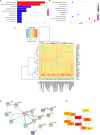Exome Sequencing Reveals Genetic Variability and Identifies Chronic Prognostic Loci in Chinese Sarcoidosis Patients
- PMID: 35860586
- PMCID: PMC9289133
- DOI: 10.3389/fonc.2022.910227
Exome Sequencing Reveals Genetic Variability and Identifies Chronic Prognostic Loci in Chinese Sarcoidosis Patients
Abstract
Background: Sarcoidosis is an inflammatory disease characterized by non-caseating granuloma formation in various organs, with several recognized genetic and environmental risk factors. Despite substantial progress, the genetic determinants associated with its prognosis remain largely unknown.
Objectives: This study aimed to identify the genetic changes involved in sarcoidosis and evaluate their clinical relevance.
Methods: We performed whole-exome sequencing (WES) in 116 sporadic sarcoidosis patients (acute sarcoidosis patients, n=58; chronic sarcoidosis patients, n=58). In addition, 208 healthy controls were selected from 1000 G East Asian population data. To identify genes enriched in sarcoidosis, Fisher exact tests were performed. The identified genes were included for further pathway analysis using Gene Ontology (GO) and the Kyoto Encyclopedia of Genes and Genomes (KEGG). Additionally, we used the STRING database to construct a protein network of rare variants and Cytoscape to identify hub genes of signaling pathways.
Results: WES and Fisher's exact test identified 1,311 variants in 439 protein-coding genes. A total of 135 single nucleotide polymorphisms (SNPs) on 30 protein-coding genes involved in the immunological process based on the GO and KEGG enrichment analysis. Pathway enrichment analysis showed osteoclast differentiation and cytokine-cytokine receptor interactions. Three missense mutations (rs76740888, rs149664918, and rs78251590) in two genes (PRSS3 and CNN2) of immune-related genes showed significantly different mutation frequencies between the disease group and healthy controls. The correlation of genetic abnormalities with clinical outcomes using multivariate analysis of the clinical features and mutation loci showed that the missense variant (rs76740888, Chr9:33796673 G>A) of PRSS3 [p=0.04, odds ratio (OR) = 2.49] was significantly associated with chronic disease prognosis. Additionally, the top two hub genes were CCL4 and CXCR4 based on protein-protein interaction (PPI) network analysis.
Conclusion: Our study provides new insights into the molecular pathogenesis of sarcoidosis and identifies novel genetic alterations in this disease, especially PRSS3, which may be promising targets for future therapeutic strategies for chronic sarcoidosis.
Keywords: adaptive immune response; chronic sarcoidosis prognosis; non-synonymous mutations; sarcoidosis; whole-exome sequencing.
Copyright © 2022 Zhang, Huang, Zhang, Fang, Wang, Jing, Guo, Sun, Yang and Xu.
Conflict of interest statement
Author MZ was employed by ANNOROAD Co. The remaining authors declare that the research was conducted in the absence of any commercial or financial relationships that could be construed as a potential conflict of interest.
Figures



Similar articles
-
Whole exome sequencing in three families segregating a pediatric case of sarcoidosis.BMC Med Genomics. 2018 Mar 6;11(1):23. doi: 10.1186/s12920-018-0338-x. BMC Med Genomics. 2018. PMID: 29510755 Free PMC article.
-
Specific genetic aberrations of parathyroid in Chinese patients with tertiary hyperparathyroidism using whole-exome sequencing.Front Endocrinol (Lausanne). 2023 Oct 3;14:1221060. doi: 10.3389/fendo.2023.1221060. eCollection 2023. Front Endocrinol (Lausanne). 2023. PMID: 37854190 Free PMC article.
-
Bioinformatics analyses of gene expression profile identify key genes and functional pathways involved in cutaneous lupus erythematosus.Clin Rheumatol. 2022 Feb;41(2):437-452. doi: 10.1007/s10067-021-05913-2. Epub 2021 Sep 23. Clin Rheumatol. 2022. PMID: 34553293
-
Exploration of the mechanism of Zisheng Shenqi decoction against gout arthritis using network pharmacology.Comput Biol Chem. 2021 Feb;90:107358. doi: 10.1016/j.compbiolchem.2020.107358. Epub 2020 Aug 8. Comput Biol Chem. 2021. PMID: 33243703 Review.
-
Current Insights in Genetics of Sarcoidosis: Functional and Clinical Impacts.J Clin Med. 2020 Aug 13;9(8):2633. doi: 10.3390/jcm9082633. J Clin Med. 2020. PMID: 32823753 Free PMC article. Review.
Cited by
-
Novel mutations and molecular pathways identified in patients with brain iron accumulation disorders.Neurogenetics. 2023 Oct;24(4):231-241. doi: 10.1007/s10048-023-00725-9. Epub 2023 Jul 15. Neurogenetics. 2023. PMID: 37453004
References
LinkOut - more resources
Full Text Sources
Miscellaneous

